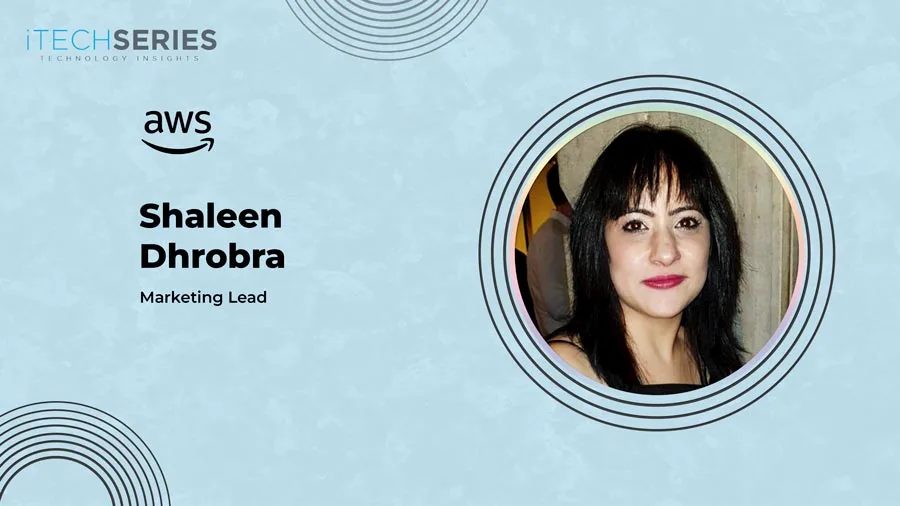Shaleen Dhrobra, Head of Marketing at Amazon Web Services (AWS) with experience across enterprises and high-growth startups, shares how she has shaped marketing into a brand-to-revenue growth engine. She discusses balancing short-term revenue with long-term brand building, leveraging AI for creativity and efficiency, using customer insights effectively, and driving cross-functional alignment.
It’s wonderful having you on this interview series, Shaleen. Could you tell us about yourself and your marketing journey?
My journey spans APAC, US and EMEA, including multiple roles in my early career in sales, customer service, and technology operations, and ultimately marketing. This enabled me to draw on those experiences and drive cross-functional collaboration to drive growth for enterprises like AWS, Salesforce, Dell EMC, and Orange, as well as deeptech startups like Scandit. It’s been incredible to drive hockey stick growth trajectories; for example, seeing Box go from scale-up to enterprise was awesome. I see marketing being at the centre of this growth journey, bringing together storytelling, data, technology, and customer obsession.
How do you balance short-term revenue goals with long-term brand growth and positioning?
I’m a strong believer in integrated marketing that works across the customer lifecycle, creating brand to demand and ultimately revenue growth and customer advocacy. Brands that build strong memory structures and emotional connections across different touchpoints capture disproportionate market share. Strong brand equity enhances performance marketing efficiency in several ways, including lower acquisition costs and higher conversions. Emotionally connected customers have a 306% higher lifetime value and will recommend brands at a much higher rate. I ensure the marketing efforts are targeted at the ICP actively engaging with us, using intent tools to map the target accounts across the funnel and having precision account-based plans for the top accounts, thinking about personas, vertical marketing, and ABM programs. Carefully considering the customer journeys, using the powerful insights we gained through our digital programs like social listening, intent monitoring, and SEO research to ensure relevant messages are delivered across channels consistently and coherently, not just from marketing but across the organisation. I work very closely with Sales, CS, and product leadership to align on messaging and focus on 1:1 and 1 few accounts lists.
As AI becomes more integrated into marketing, how can teams leverage automation for efficiency while preserving creativity and authenticity?
AI has huge potential for marketing teams when used correctly, from creating hyper-personalized experiences and optimizing campaign performance to research and deep customer insights. Smart teams are using AI to boost creativity and not replace it. I encourage my teams to use this for ideation, as a thinking partner, and to think of small use cases where this can solve administrative or repetitive tasks. Prompt engineering is a skill in itself! Make sure to be as precise and detailed in your prompts, thinking of the situation and who you want the AI to act like, and even include a prompt for the AI to ask clarifying questions. It’s best to test and use different AI tools out there like Claude, Gemini, OpenAI, etc., and have a culture for sharing ideas and best practices. As this is a rapidly evolving field, building that culture of innovation & learning helps adoption and creates impact.
How do you consistently integrate customer insights and feedback into your marketing planning and execution?
CMOs must justify spending by leveraging AI-driven analytics, refining attribution models, and aligning marketing efforts with measurable business outcomes. Implementing a Data-Driven marketing planning process, combining advanced data analytics with local human expertise to create a comprehensive SWOT monitoring system. We’ve moved beyond traditional market research to build a robust first-party data ecosystem that helps us anticipate market shifts. For example, we developed an early warning system that successfully predicted and helped us anticipate demand from our Top 2000 accounts by combining intent signals and customer sentiment analysis with geopolitical indicators.
“I’m a strong believer in integrated marketing that works across the customer lifecycle, creating brand to demand and ultimately revenue growth and customer advocacy.”
What key metrics do you focus on when evaluating the success of your marketing campaigns?
In order to understand the overall impact of marketing campaigns, it’s important to look at short-term and long-term KPI’s aligned to reach, reputation, and revenue. Website traffic, impressions, and click-through rate show the short-term impact on reach, whereas Unique visitors and Organic search ranking show the longer-term impact on our Brand Reach. Likewise, brand mentions and social media engagement help us understand short-term impact on reputation, while our annual analysis on sentiment, share of voice, and Net Promoter Score shows longer-term brand reputation impact. When it comes to revenue, we measure Return on investment as well as conversion rates from lead to opportunity and ultimately closed-won revenue.
How do you foster collaboration across marketing, sales, and customer success teams to ensure alignment and drive unified growth?
True collaboration is when both teams share goals/outcomes and insights and leverage technology and AI to deliver seamless, personalised experiences that accelerate adoption, improve customer retention, and maximise revenue. By understanding each team’s strengths, agreeing on shared goals, and integrating AI-driven tools, organisations can create GTM engines that deliver value for customers as well as shareholders. It starts with having a shared vision and a teamwork mindset and is brought to life through mechanisms that drive open, honest conversations and learning loops. Especially in large global organisations, it’s important to create local/team-level alignment along with leadership alignment. Marketing is well placed to have an end-to-end customer lifecycle view and often orchestrates the alignment and cross-functional collaboration.
What advice would you give to aspiring marketers looking to build a successful career in today’s fast-evolving marketing landscape?
Marketing is often remembered for the outcomes, like the Nike brand or the revenue figures, but great marketing needs a deep understanding of human behaviours, performance insights, and delivering customer outcomes. We have extensive MarTech stacks and AI tools you can use (and should get a great grasp on), but do also spend the time in understanding the customer challenges you are trying to solve and build relationships across your organisation, as well as externally in your space. As the recent AI drive becomes mainstream, that will be your true differentiator. Think of your own career as your most important product; you want to drive growth for it!
About Shaleen Dhrobra
With over 15 years of global sales and marketing leadership experience, Shaleen Dhrobra has driven revenue growth and digital transformation across B2B and B2C organisations worldwide. A CIM-qualified marketer and PRINCE2-certified project manager, she has led budgeting, strategic planning, and cross-functional execution within complex matrix environments. Her expertise spans demand generation, digital change management, account-based marketing, content strategy, analytics, and partner marketing, backed by proven leadership in hiring, mentoring, and performance management.









